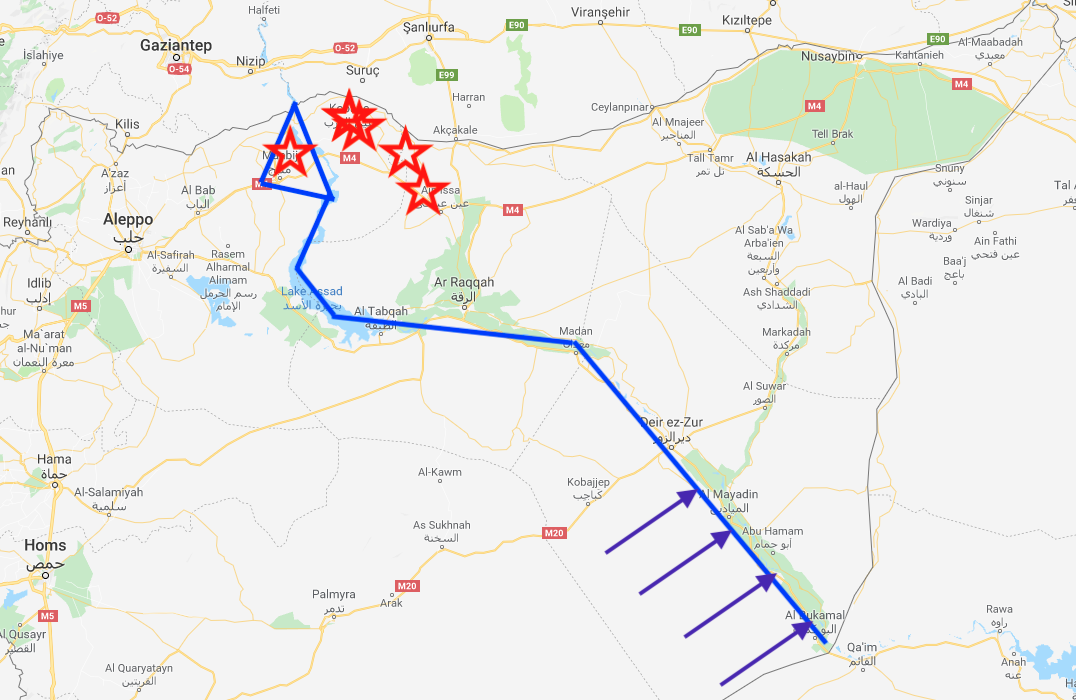In a speech on Wednesday, Turkish President Recep Tayyip Erdogan pledged to launch an imminent military operation east of the Euphrates river in Syria. It’s a warning shot to U.S. forces in Syria.
Erdogan asserted that “[o]ur target is never U.S. soldiers,” but he cannot be trusted. After all, U.S. forces are embedded with the very Kurdish YPG militia group that Turkey is targeting. A variant-Marxist militia that has been instrumental in pushing back ISIS alongside U.S. and allied forces, the YPG are hated by Erdogan for their alignment with the PKK Kurdish terrorist group. The U.S. had pledged to restrain the YPG from advancing its territorial claims along the Turkish border, but it hasn’t yet done so. That leaves us where we are now.
My map below shows, roughly, the current areas of U.S./YPG control within the blue triangle at Manbij, and to the left/east of the blue line along the Euphrates river. The red stars roughly represent Turkish military positions against these YPG-held areas. The purple lines represent Russian-Assad-Iranian efforts to push the U.S. off its Euphrates position.

So what should the U.S. do in response to Erdogan’s threat? A couple of things. First, the Trump administration should make clear that any hostile action against the YPG will lead to an immediate and significant deterioration of U.S.-Turkish relations. The U.S. is in a catch-22 position with its YPG and Turkish allies, but it cannot stand by and watch the Turks smash their way through the YPG. Moreover, the close cooperation of YPG and U.S. military forces in the areas of Turkish concern means that any Turkish military operation will greatly endanger U.S. personnel. That’s exactly why Erdogan is trying to get ahead of the risk of U.S. casualties by saying that any Turkish-inflicted U.S. casualties that do occur will be accidental.
But the U.S. cannot allow Erdogan to believe that this excuse will absolve him of responsibility. Erdogan must be made to know that U.S. forces will be defended robustly and that any U.S. casualties will result in major sanctions. The U.S. must also stand firm here because Erdogan is almost certainly being influenced by Russian President Vladimir Putin. As noted above, the Russians want the U.S. out of Syria, and they want to consolidate Turkey in support of their looming offensive against Idlib. For these reasons, Putin will love the prospect of U.S. forces being killed by their Turkish counterparts.
At the same time, the U.S. must recognize that the Turks have a point about the YPG positions. From Turkey’s perspective, the U.S. is assisting a terrorist enemy in threatening Turkish territorial integrity. In turn, the U.S. should make clear to the YPG that they must vacate the top areas of Turkish concern within a short period of months. To compensate the YPG, the U.S. should provide generous financial and infrastructure support and a pledge to advocate for Kurdish interests outside of the Turkish orbit.
Ultimately, however, the first necessity lies in stopping or restraining Erdogan’s offensive. That offensive threatens U.S. personnel and interests and would only serve Syrian President Bashar Assad and Putin’s aggression.

